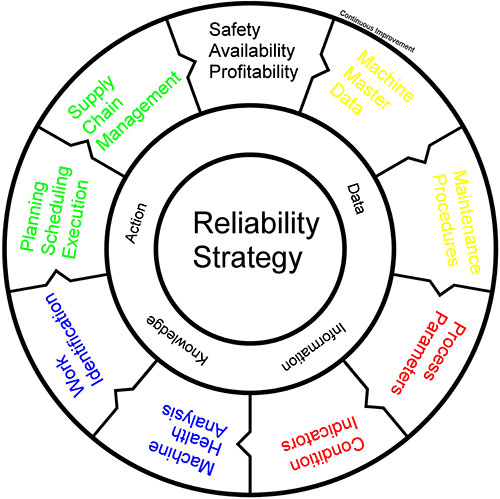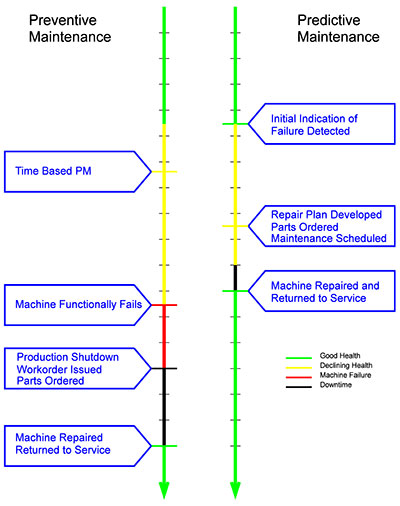|
Search: |
|
Search: |
HOME → ARTICLES → The Industrial Internet Of Things & Industry 4.0 in Gravity Die Casting

President
CMH Manufacturing Company
www.cmhmfg.com
But has it? The Internet has changed most things in our daily lives. We no longer read paper books, we read an iPad. We no longer buy records or CDs, we listen to our iPhone. We no longer read newspaper, we read Facebook. We no longer watch cable TV, we watch Apple TV. We no longer shop at the mall, we shop on Amazon. We no longer talk on the phone, we Skype, text, or email.
With all the changes internet technology has brought us, most foundries today use the twentieth century discrete manufacturing method. Discrete manufacturing is an industry term for the manufacturing of finished products that are distinct items capable of being easily counted, touched or seen. In theory, a discrete product can be broken down at the end of its lifecycle so its basic components can be recycled. In most discrete casting cells today the PLC (Programmable Logic Control) is not connected to the Internet.
Foundries today are facing the new world of IIoT (Industrial Internet of Things) and Industry 4.0 or the fourth Industrial Revolution and these hyped up dreams are quickly becoming reality. Regardless of what devices are sensored, connected, integrated, IIoT will continue to expand and change processes for casting. The competitive gains realized by increased and consistent visibility, accuracy and data driven insights on foundry equipment and casting processes results are to important to ignore.
IIoT provides benefits across four key areas:

Foundries in the USA have been slow to adapt to robotics and advanced automation. Imagine a foundry with IIoT using robots, drones, voice powered artificial intelligence (AI) and virtual reality solutions to increase safety, quality, productivity, and bottom line results. IIoT could allow a foundry to operate with no unscheduled downtime, in other words no BREAKDOWNS.
How do we achieve no unscheduled down time? In the past all foundries used reactive maintenance. Run a piece of foundry equipment until it stops then repair it. We still see this in high volume automotive foundries today when JIT suppliers cannot take the time to do preventive maintenance and must react when a machine fails. IIoT will change the way foundries do maintenance by moving from reactive/preventive/predictive maintenance to prescriptive maintenance (RxM). RxM will allow analytics to show that a piece of equipment is headed for trouble and prescribe prioritized, pre-determined, expert driven mitigation or repair. Foundries will have to abandon their old habits such as reactive/preventive maintenance and be prepared to act on detailed information that predicts machine failure.
Will Goetz’s (Emerson) Reliability Value Chain illustrates how the foundry manager can fit all the pieces together to achieve zero breakdowns, continuous improvement, and RxM. The foundry manager must see the entire casting process holistically. From the value chain there are four categories: obtaining accurate data, translating the data into information, gleaning knowledge from the information, and developing an action plan from the knowledge gleaned.
The value chain illustrates how sensors on smart foundry equipment are used to monitor the causes for a machine to no longer contribute to the process. In other words, failure does not mean that the machine stops working, it means that it is not contributing to the process as designed. Condition monitoring and predictive technology can detect when the machine is not performing within specified parameters giving the foundry manager time to take action.
Foundry managers can move their foundry to PdM and prepare for RxM and for the adoption of IIoT by doing three simple things.
Top performing companies using RxM via IIoT, like Emerson and GE, have strong machinery reliability with low maintenance cost simultaneously. Foundry managers currently focus on the most attention grabbing issue while process availability suffers. Because most foundry equipment failures occur at random equipment age intervals, a time based preventive maintenance activity can allow a breakdown, resulting in more downtime than a RxM approach. Hard failures of equipment are more expensive to repair due to costs of procuring parts on short lead time, collateral damage to the machine, and the labor cost of over time repair. These are direct costs and do not take into account any indirect cost such as ill-will or personnel problems resulting from the breakdown. Will Goetz’s graph shows that preventive maintenance is ineffective and results in more loss of time than RxM.

Industry 4.0 is a name for the current trend of automation and data exchange in manufacturing technologies. It includes cyber-physical systems, IIoT, cloud computing and cognitive computing. Industry 4.0 creates what has been called a “smart factory”. It is called Industry 4.0 because it is the fourth industrial revolution. The three prior revolutions of the modern era are:
Modern information and communication technologies like cyber-physical system, big data analytics and cloud computing, will help early detection of process defects (scrap) and production failures (downtime), thus enabling their prevention and increasing productivity, quality, and agility benefits in job shops that have significant competitive value.
Big data analytics consists of 6Cs in the integrated Industry 4.0 and cyber physical systems environment. The 6C system comprises:
In this scenario and in order to provide useful insight to foundry management, data has to be processed with advanced tools (analytics and algorithms) to generate meaningful information. Considering the presence of visible and invisible issues in a foundry, the information generation algorithm has to be capable of detecting and addressing invisible issues such as machine degradation, component wear, etc. on the foundry floor.
Imagine a rotary table casting machine sending a notice that a wheel bearing on station six will fail in the next ten days. Then create and schedule a work order specifying if the bearing is to be replaced or simply greased.
For a foundry or system to be considered Industry 4.0, it must include:
Challenges in implementation of Industry 4.0:
Every foundry and manufacturing company is on the road to IIoT and Industry 4.0. One might be at 2.6 or 3.1 but a manufacturer must accept the challenge and make the change one step at a time. By doing this we can expect zero downtime in gravity die-casting. Additionally, we can also expect to attract a younger and higher skilled workforce. We will retain them longer by providing greater mental challenges and less “getting hot and dirty on the foundry floor”.
Where do USA foundries stand in the global acceptance of IIoT and Industry 4.0? With this being a German concept puts Germany and Western Europe in first place, but China and India are in a strong race for second and third with the USA coming in last. It is time for American foundries to accept the future of the global foundry industry and work towards zero downtime.